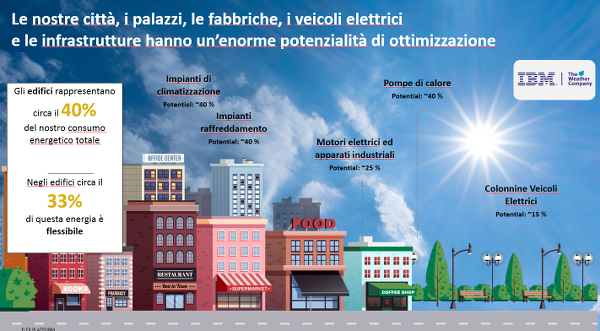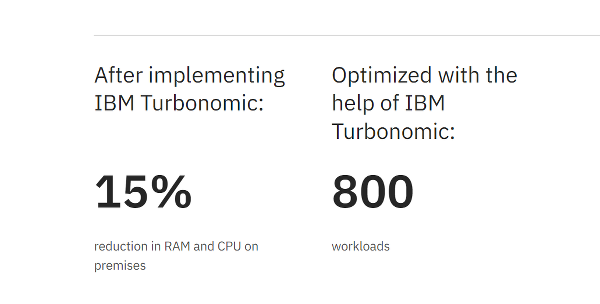Being able to carry out environmentally friendly businesses has become the priority, especially in Europe, the continent that is doing the most to fight global warming. To be able to remain competitive on the market while reducing CO2 emissions at the same time, there is only one way: to exploit technology to optimize processes, make them more efficient, reduce waste to the minimum possible.
There is room for improvement, starting with the infrastructure: by intervening on factories, buildings, warehouses, but also electric motors and industrial equipment, it is possible to significantly reduce emissions. Buildings, for example, account for 40% of Italian energy consumption. According to IBM estimates, it is possible to reduce the energy used by air conditioning, cooling and heat pumps by 40%but it is also possible to optimize the use of electric motors of industrial equipmentreducing consumption by 25%, and also columns for recharging electric vehicles could consume up to 15% less. All without replacing the devices, but only by exploiting the technology to use them more efficiently.

Let’s see some examples of how IBM has supported partners and customers in the decarbonization process.
Intelligent infrastructures: the cases of the Milanese Metro and Autostrade
As indicated at the beginning, buildings are the infrastructure responsible for the largest percentage of consumption: by intervening on buildings and homes, it would be possible to make significant progress in reducing emissions. An example comes from Milan Metrowho chose the platform Beam IoT of IBM to more effectively manage water distribution and its building stock. The Metropolitana Milanese implementation is currently capable of handling 100,000 IoT sensors, but is designed to scale as needs grow.
Beam IoT collects data from these sensors, located on networks and plants, in a data lake. Thanks to this information, MM technicians will be able to analyze this mass of information with analytical tools, so as to detect inefficiencies and optimize the systems. Not only that: this information is also useful for designing new services to be made available to users, also generating new business.
“With the Beam IoT system, MM has finally equipped itself with a transversal and scalable enterprise platform capable of collecting data from the sensors that control its networks and systems in real time”. explains Stephen Cetti, General Manager of MM. “Thanks to the availability of an organized Data Lake, it will be able to analyze big data to create efficiency, effectiveness and the development of new services for citizens and users of the city of Milan“.
With Highways for ItalyInstead, IBM built the digital platform Argon, designed to solve the age-old problem of managing motorway infrastructures such as bridges, viaducts and tunnels. An investment in this case aimed more at security, understood as physical security (safety) than energy saving.
Argo was developed by IBM e Movyon and leverages AI and IoT to keep infrastructures under control, also reducing maintenance costs. Currently, the solution keeps 3,800 bridges and overpasses under control. But what does it do, exactly? The infrastructural assets are digitized through Argo which are then archived in a database. A mobile app supports technicians in the infrastructure inspection phases, both remotely and in the field.
The digital transformation of Rome Capital
One of the problems that the administration of Rome has found itself facing is that of digital services for citizens. The solution implemented for the city was starting to show its age: we are talking about a monolithic digital infrastructure, which could not be modernized by leveraging microservices due to the lack of adequate tools. And it was now complex to maintain efficiency.

To overcome these problems, the platform was adopted IBM Turbonomic Application Resource Management, which provided greater visibility into the infrastructure, enabling IT teams to optimize the use of hardware resources. The result is that it was possible to reduce the RAM and the number of processors by 15%, reducing the costs associated with the hardware and, of course, energy consumption by 10%.
Separate collection? Hera has enhanced it with AI from IBM Watson
An example of how technology can support circular economy processes comes from Hera, which has adopted a solution developed by IBM Garage which leverages on IBM Watson Studio e IBM Watson Machine to recognize the characteristics of objects and recover and reuse plastic more effectively.
“With IBM we have been able to activate a particularly innovative solution in the field of waste collection, selection and recovery: the project is positioned along the entire operational chain and can be a valid support to increase its efficiency, but above all it can affect the improvement of quality of separate waste collection, on maximizing recyclable waste, making full use of the efforts put in place by the Hera Group in the circular economy“, he has declared Milena ZappoliInnovation Manager of the Hera Group’s Environmental Services.
The ButanGas case
Butangas, one of the main Italian players in the LPG sector, in 2021 started a process of renewal of its technological infrastructure. To take care of the project IBM and the partner labinfwho have decided to upgrade the systems on premise of ButanGas adopting two IBM Power servers and IBM FlashSystem 700 and 5000 storage systems. The result? The speed of execution has grown significantly, the execution of transactions has improved by 20-30% reaching peaks of 40-50% in the case of reports and complex procedures, all without saturating the machine’s resources. Backup times have been halved, the RPO (Recovery Point Objective) has been reduced to less than 5 minutes while the RTO (Recovery Time Objective) has been reduced to less than 30 minutes.
“The period we are experiencing is particularly complex also due to the highly unstable geopolitical scenarios“, he has declared Demetrius Moscato, Deputy General Manager, ButanGas. “This requires extreme flexibility, speed and the ability to accept changes in order to face the challenges that even a sector like ours has to face. One above all: the energy transition. We also want to be protagonists on the digital side where, also as a consequence of the pandemic period, the real-time response to the needs of our customers is increasingly becoming an essential priority. Reliability, modernization and innovation are the characteristics that led us to identify the IBM Power platform as the one most in line with our objectives. An efficient and resilient platform for business, capable of delivering applications and insights securely, where and when they are needed”.
